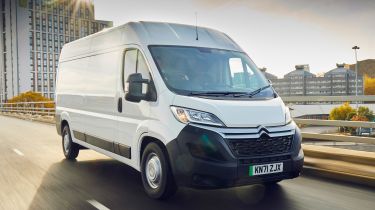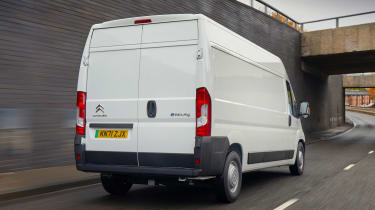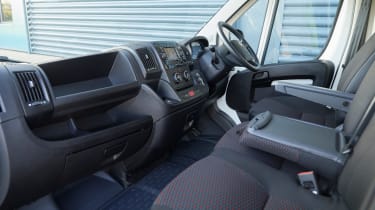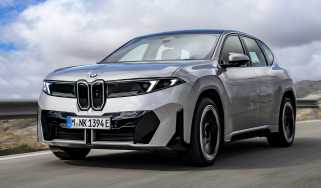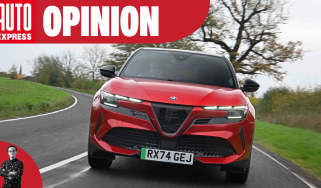New Citroen e-Relay van 2022 review
The Citroen e-Relay is a welcome addition to the electric van world, but it's held back by its lack of range
Verdict
The Citroen e-Relay isn't the best large electric van for sale - that accolade goes to the closely related e-Ducato – and the quirks that come with Citroen’s effort mean that it feels more like an aftermarket conversion than an officially sanctioned product. However, it serves a purpose, and it has versatility on its side, thanks to the two battery sizes on offer, the different panel van lengths available, and that chassis cab option for tailor-made conversions. Just don't expect to venture very far very quickly before needing to recharge that battery.
Large electric vans have carved out quite a niche in the market, and a recent arrival is the Citroen e-Relay. It follows the form of other models in the class, such as the Renault Master E-Tech, Mercedes eSprinter and Fiat e-Ducato, by incorporating its electric tech in an existing model design. In this instance, diesel Relays are shipped to a third party manufacturer based in Turkey, where the engine, gearbox and fuel system are replaced by a 118bhp electric motor and a choice of two lithium-ion battery packs, either 37kWh or 70kWh.
That smaller battery offers a WLTP-tested range of up to 73 miles, while the larger pack offers up to 139 miles, which by any measure are pretty modest range figures. However, when you consider the sheer size of these vans, that's to be expected. Vans like this are designed with last-mile, short, urban delivery routes in mind, although anyone driving the 37kWh van might get a bit anxious that they'll have enough range to cover a day's work.
As with its rivals, fitting the battery pack hasn't dented the e-Relay's cargo volume. The electrified Relay comes as a panel van in L2H2, L3H2 and L4H2 sizes, plus there's an L4H2 Window Van available and a Chassis Cab option, too. This means there's up to 15 cubic metres of cargo space on offer in the e-Relay, while a payload of up to 1,150kg is possible in the heavy vans.
One advantage that the e-Relay offers over most rivals is that it has 50kW rapid charging fitted. This means it's possible to recharge the battery from 0-80 per cent using a DC power source in an hour. That's the same time for both batteries, while the 37kWh battery can be charged from a 22kW source in three hours, or six hours via a 7.4kW chargepoint. For the 70kWh battery, these times are nine hours and 12 hours respectively.
Used - available now

2021 Hyundai
Ioniq hybrid
20,857 milesAutomaticPetrol1.6L
Cash £15,262
2025 Hyundai
Tucson
2,534 milesAutomaticPetrol1.6L
Cash £31,806
2025 Hyundai
Kona
1,619 milesAutomaticPetrol1.6L
Cash £27,180
2022 Vauxhall
Mokka Electric
7,967 milesAutomaticElectric
Cash £14,549Climb aboard, and there are a handful of very obvious changes to the e-Relay when compared with the diesel van. Firstly, there's a lack of gearlever. Instead, a blank panel is fitted where the shifter should be that features a trio of brushed aluminium push buttons to select Drive, Neutral and Reverse. The other change is down to the right of the steering wheel, where there's a digital display and buttons that control the cabin temperature. With the removal of the diesel running gear, the standard van's heater has also gone, so a new system is installed in its place.
However, the original controls for the heating are still in place - there'd be a gaping hole in the centre of the dashboard if they were removed – and the fan speed and vent controls all still work, it's just that the temperature control is substituted for the new display down by the driver's right knee. It's a bit of a fiddly system to use, and also means passengers can't control the van's temperature, but it's a system you get used to.
The other oddity of the e-Relay is that while the diesel van's instruments remain, it's only the speedometer that works - the needles for the rev counter, fuel gauge and water temperature have all been removed to emphasise the fact they're no longer in use. To check the status of the van's battery (its remaining charge and energy flow) there's a digital display located within the rear-view mirror instead. It's an odd place to have this information, but is a simple way of adding it without reprogramming the van's five-inch touchscreen, and it makes the mirror useful when in normal circumstances it would just reflect the steel bulkhead behind the seats.
Out on the road, the relative lack of power for the e-Relay is evident as soon as you try and pull away with any vigour. Having 118bhp on tap means the van builds speed rather than accelerates - there's none of the neck-snapping force you'll get in a Tesla, that's for sure - and everything happens rather sedately. It's most pronounced at busy roundabouts, where an extra burst of speed would help you to merge, but floor the throttle in the e-Relay, and not a lot happens.
Things are better when you're moving, although throttle response can be a little jerky. There's also a constant whine from the electric motor, which isn't noisy, but leaves you with a tinnitus-like whistle in your ears at all times. At least the e-Relay is far quieter than a diesel Relay. In fact, it's so quiet that you can even hear the power steering pump whirring away whenever you turn the wheel.
There's some energy recovery when you lift off the throttle, although again this feels inconsistent. On some occasions the van starts to slow noticeably, while at others it simply coasts. The push-button drive selector is easy to use, simply press the individual buttons for forward, neutral and reverse, while backing up is made easier thanks to parking sensors and a reversing beep to warn other road users when you manoeuvre. Our other criticism of the e-Relay is forward visibility. While the windscreen is vast, your view to either side is hindered by the van's A-pillars and the frames for the quarterlight door glass - it can be quite obscured when pulling out of junctions.
Overall, the Citroen e-Relay is a mixed bag. It's far from being a front-runner in the large electric van class, and feels more rough and ready than most rivals. That includes the closely related Fiat e-Ducato. While both companies are now part of the Stellantis group, these vans are a remnant of development pre-merger. As a result, the e-Ducato goes its own way with batteries and electrical integration, and it's a lot better for it. The sooner the e-Relay benefits from the same running gear, the better.
| Model: | Citroen e-Relay L3H2 70 kWh Panel Van Enterprise |
| Price: | From £57,035 (incl £5,000 PiVG) |
| Powertrain: | 70kWh battery, 118bhp electric motor |
| Transmission: | Single-speed auto, front-wheel drive |
| Top speed: | 75mph |
| WLTP Range: | 139 miles |
| Maximum payload: | 740kg |
| Cargo volume: | 13 cubic metres |
| On sale: | Now |

